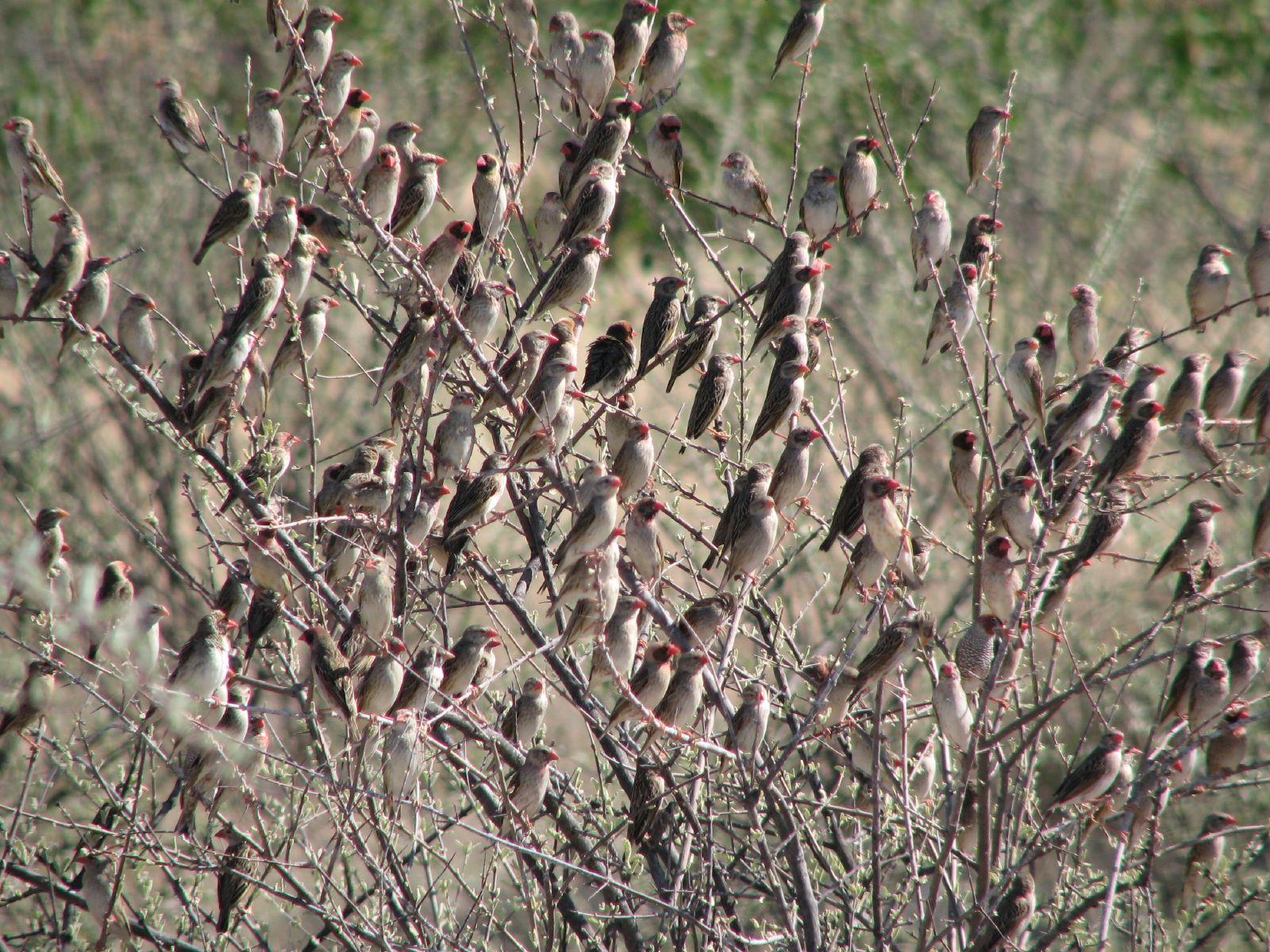- Red-billed Quelea
Taxobox
name = Red-billed Quelea

image_caption = Flock of Red-billed Queleas
image_width = 240px
status = LC | status_system = IUCN3.1
regnum =Animal ia
phylum = Chordata
classis = Aves
ordo =Passeriformes
familia =Ploceidae
genus = "Quelea "
species = "Q. quelea"
binomial = "Quelea quelea"
binomial_authority = (Linnaeus, 1758)The Red-billed Quelea ("Quelea quelea") is the world's most abundant
bird species (excluding domesticated species), with an estimated adult breeding population of 1.5 billion. [Weaver Bird Natural History [http://www.junglephotos.com/africa/afanimals/birds/ploceusnathist.shtml] ] It is a smallpasserine bird of the weaver family Ploceidae, native tosub-Saharan Africa .Characteristics
Red-billed Quelea grow to about 12.5 cm long and 15 to 20 g weight. During breeding the male is distinguished by its more colorful plumage and red bill. Breeding plumage in male queleas is unusually variable: comprising a facial mask which ranges from black to white in color, and breast and crown plumage which varies from yellowish to bright red. For the rest of the year male plumage resembles that of the female, which is a cryptic beige coloration. The female's bill is yellow during breeding, and red during the non-breeding season.
Habits
Red-billed Quelea live and breed in huge flocks. Which can take up to 5 hours to fly past. mostly in
steppe andsavanna regions, but not avoiding human settlements. While foraging for food they may fly large distances each day without tiring. Their life expectancy is two to three years.Reproduction
The breeding season begins with the seasonal rains, which come at different times in different parts of their range - starting at the north-western edge around the beginning of November. The breeding males first weave half-complete ovoid
nest s fromgrass andstraw . After the female has examined the construction and the mating has occurred, both partners complete the weaving of the nest. The female lays two to four light blue eggs, and incubates them for twelve days. After the chicks hatch, they are nourished for some days withcaterpillar s andprotein -richinsect s. After this time parents change to mainly feedingseed s. The young birds fledge and become independent enough to leave their parents after approximately two weeks in the nest. They are sexually mature after just one year, but many females die before this time, leaving many males without a partner.Food
The food of the Red-billed Quelea consists of grass seeds and grain. As soon as the
sun comes up, they come together in their huge flocks and co-operate in finding a suitable feeding place. After a successful search, they settle rapidly and often cause serious damage to crops. In the middle part of the day they rest in shady areas near water and spend the time preening. In the evening they once again fly in search of food.Distribution
The distribution area of the Red-billed Quelea covers most of sub-Saharan Africa, excluding the
rain forest areas and parts ofSouth Africa . They are regarded as pests by farmers because of their greed, and often compared withlocust s, which fall upon grain andrice fields. Since they have hardly any natural enemies, their population is enormous, some 1.5 billion individuals. Even extreme control measures such as dynamiting the nest colonies and use oforganophosphate poisons have not significantly reduced their numbers. They can also elimate many African fields in a short period of time, rarely leaving behind more than a single grain. [cite news |first= Isah |last= Ibrahim |title= Queller birds destroy farm crops in Zamfara |url= http://odili.net/news/source/2007/aug/16/5.html |work=The Guardian (Lagos) |publisher= Guardian Newspapers Limited, via nigeriaworld.com|date= 2007–08–16 |accessdate=2008-04-05 ]References
* Database entry includes justification for why this species is of least concern
External links
* [http://www-web.gre.ac.uk/directory/NRI/quel/index.htm NRI Quelea Breeding Forecast Models]
* [http://www.hbw.com/ibc/phtml/especie.phtml?idEspecie=8549 Red-billed Quelea] videos on the Internet Bird Collection
Wikimedia Foundation. 2010.
